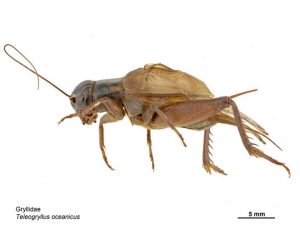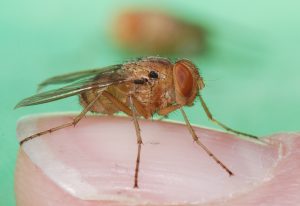Pacific field crickets (Teleorgryllus oceanicus) are found throughout islands in the Pacific ocean, Oceania, and coastal Australia. In most of that range, male crickets sing in order to attract mates, but in the Hawaiian Island Kauai, the crickets are surprisingly silent. This is because in the past 15 years, about 90 percent of male crickets have evolved a mutation which gets rid of the sound-producing structures in their forewings preventing them from singing. Scientists call these crickets flatwing crickets.

Pacific field cricket (Teleogryllus oceanicus)
The flatwing mutation makes it difficult for the crickets to attract mates, and they often rely on intercepting a female attracted to the call of a normal-wing (capable of singing) cricket. However, the mutation also protects them Ormia ochracea, a deadly parasitoid fly which locates the crickets through their song. In this way, the flatwing mutation gives males a serious advantage in terms of survival, but makes it harder for them to find mates. Evolutionary biologists call this a trade-off between sexual selection (which favors traits that help animals find mates) and natural selection (which favors traits that help animals survive). But how does the flatwing mutation affect female crickets, who can also inherit the gene and now live in an environment with significantly less mating songs? In a new study called “Direct and indirect effects of sexual signal loss on female reproduction in the Pacific field cricket (Teleogryllus oceanicus),” Heinen-Kay et al set out to answer this question. This study gives unique insights into the evolution of sexual signals, a phenomenon that scientists rarely get to see in action.

The parasitoid fly Ormia ochracea locates Pacific field crickets using their mating calls
First, Heinen-Kay et al investigated how the flatwing gene impacts female crickets. No female Pacific field crickets can sing so there are no obvious affects of the gene on females, but the scientists studied if the gene had other affects on the female reproductive system. Female crickets can inherit 2 copies of the flatwing gene (called homozygous flatwing), 2 copies of the normal, non-flatwing gene (called homozygous normal-wing), or one copy of each gene (called heterzygous). Heinen-Kay et al bred captive populations of homozygous flatwing crickets and homozygous normal-wing crickets from the wild Kauai population, and then compared the reproductive tissue mass and number of offspring of females in both groups. Flatwing females had significantly smaller reproductive parts, but laid the same number of eggs as their normal-wing counterparts. This means that flatwing females are investing less of their energy and resources in growing their reproductive parts, but this is not affecting the number of offspring they reproduce. This suggests that they may have more energy and resources to invest in other biological functions. However, Heinen-Kay et al did not investigate the health of the offspring, so it is possible that the normal-wing females had healthier offspring.
Next, the researchers asked the sound environment (lots of mating calls or no mating calls) a female cricket grows up in impacts the development of its reproductive system. This is a question of trait plasticity — elements of an animals development that are impacted by its environment instead of its genes. To answer this question, Heinen-Kay et al compared used populations of female crickets from Kauai (where ~90% of males are flatwing), Oahu (where ~50% of males are flatwing), and Mangaia (where no males are flatwing and the sound-honing parasitoid fly is not found). For each population, they compared females raised in environments with and without mating songs. For the Oahu and Mangaia populations, females raised in an environment without songs had significantly smaller reproductive parts. But for the Kauai population, the presences of a mating song did not significantly impact the development of the female. This suggests that about 15 years (or 70 cricket generations) in a nearly song-less environment has impacted how female Pacific field crickets in Kauai respond to their environment.
This study reveals that changes in male reproductive behavior can impact female physiology, both through genetic changes and changes in the environment. However, it also shows that the impacts of sexual signalling are complex and many more questions still need to be asked.
